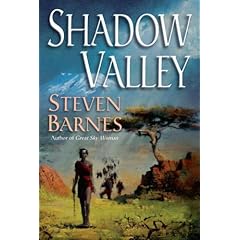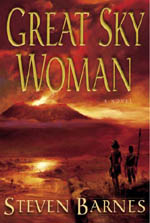I got an email from a friend that referenced Joseph Campbell's influence on George Lucas, and I wrote the following note in return. I thought you might find it interesting, even if it only recaps things I've said before... A.-- ᅠ You've touched on an area I know something about. Joseph Campbell's work did indeed inform George Lucas, but the basic work isn't based on the Hopi any more than it is the African griots, Eskimo shamans, Irish Bards and Hollywood screenwriters he studied for decades before writing his amazing thesis on the "Hero with a thousand faces." It details the underlying story behind all human mythology, the "Hero's Journey." It can be found all over the world, and elements of it can be seen in any story that has any staying power at all. Where did it come from? Well, in essence, it is the core story of human life itself. I've been using it for decades to teach writing to my students, and it's the perfect fiction structure. ᅠ Hon, you feel that you have an important message to get out to people. Fine. What I was trying to convey to you is that there are two basic ways to do this in the form of fiction: 1) Be a world-class expert, so famous that people will read your words even if they are dull. 2) Be a world-class storyteller, so skilled that you suck the reader in with your first line, and keep them reading even if they have no idea who you are, or where you are taking them. ᅠ The entertainment value then becomes the " carrier tone" that conveys your message. The "Hero's Journey" is a great way of understanding what storytelling is, and why it works. There's a whole world of things I know nothing about, darling, but on this subject, after publishing three million words of fiction and teaching thousands of students, I am world class, and I speak with confidence. I'm only talking to you about this stuff 'cause I love you. ᅠ So, then...what is the Hero's Journey? I'll lay it out in ten steps, relating it both to fiction (Star Wars IV, "A New Hope") and real life (trying to learn to ride a bicycle.) The beautiful thing about the HJ is that you can apply it to any problem you have in life. Me personally, I apply it to what I consider the core Intelligence Test in life: how can you 1) have a healthy, sexy body (look great naked!) 2) A terrific, passionate marriage/relationship and deep self-love 3) Make plenty of money doing something you love doing. ᅠ I figure that if you can do all three of these things, you have the foundation of a great life: everything else flows from these. "A" is Star Wars. "B" is a kid wanting to learn to ride a bike. ᅠ So here are the steps of the Hero's Journey. 1) Hero Confronted with a Challenge. a) "Come with me, Luke! Learn the ways of the Force." b) "I want to ride a bike!" 2) Hero Rejects the Challenge a) "I promised Uncle Owen I'd stay for the harvest." b) "I'm scared. I can't" 3) Hero Accepts the Challenge a) Uncle Owen and Aunt Baru killed. "I want to come with you and become a Jedi like my father." b) "I'll try. I want it more than I am afraid of it." 4) The Road of Trials a) Journey to Mos Eisley, Alderan, the Death Star, etc. b) Practice. Falling down, getting up, falling down, getting up... 5) Allies and Powers a) Obi-Wan Kenobi, Han Solo, Princess Leia, etc. In other words, all of the people who could teach or support Luke. Most specifically, the people who have ALREADY BEEN where Luke needs to go. These are allies. "Powers" are: using a light saber, piloting a starship, developing courage, etc. b) Mommy, daddy, brothers, sisters. Anyone who can already ride a bike, and can offer INFORMED advice. Powers are: balance, confidence, concentration, etc. 6) Confront Evil--Defeat a) The death of Obi-Wan, who was Luke's major role model. b) Falling off the bike into the rose bush. In pursuing any goal, there are points of failure. ANY goal. Get over it. 7) Dark night of the Soul a) During the assault on the Death Star--everyone killed, Luke alone. The computer can't make the shot. b) Screaming and crying. "I can't do it! I'm not big enough! I don't wanna!" 8) Leap of Faith a) "Trust your feelings, Luke" b) "Trust Daddy. I've never lied to you. You can do this!" 9) Confront Evil--victory a) Blows up Death Star. b)Learns to ride! 10) Student becomes the teacher a) Luke awarded medals and applauded by audience. Medals represent meritorious performance worthy of emulation. b) teaching your kid sister to ride! ## If you look at any movie, you'll see aspects of this pattern, because it is the course of human life itself. The only movies books or stories that have no relation to this pattern are totally experimental works that are seen by simply dozens of people. ᅠ If you look into you own life, at anything you've ever gotten good at, you'll see this pattern. If you can build it into your writing, you will instantly increase its readability vastly. If you look at any problem in your life, you can see how you can organize your resources or seek superior role models to improve your results. ᅠ THIS is the gift that Joseph Campbell gave us: he showed us the path of human life. This is genuine wisdom, the elders of every village in the world showing the children how to face their futures with power and courage. I know of no single piece of information that is more important.
###
Wednesday, March 18, 2009
Recap
Posted by
Steven Barnes
at
9:40 AM
![]()
Subscribe to:
Post Comments (Atom)







4 comments:
Hey steve, you might enjoy The Scribblers Guide To The Land Of Myths which has several interpretations of the hero's journey, the anti-hero's journey, and other mythic events.
Here's something you might find interesting, Steve. I'm guessing you might already know this but I thought I'd post it for those who might not.
When Campbell was younger he wanted to be a fiction writer so he took some classes with John Gallishaw.
Gallishaw wrote three books on fiction writing, which were considered required reading at the time. His teachings on universal patterns in fiction influnced not only Campbell, but William Foster-Harris and Stanley Vestal who founded the Professional Writers' Program at the University of Oklahoma.
And these men were mentors of Dwight Swain. A lot of people think that the whole scene/sequel thing started with Swain. It was actually first mentioned by Gallishaw in his book 'The Only Two Ways to Tell a Story.' Foster-Harris and Vestal mention it and Gallishaw in their books. Foster-Harris said when finally understood scene writing, he started to sell.
So Gallishaw might just be the most influential writing teacher in American history and almost nobody remembers him. :) I also find it interesting that most of the useful concepts in fiction writing can be traced back to one guy (he teaches about MRU's as well just calls then Stimulus/Response).
Steve,
A note on the Mandela quote from today's 101 program: it turns out to be by by Marianne Williamson
from A Return To Love: Reflections on the Principles of A Course in Miracles.
Just read this today: "This quote is often found on the Internet incorrectly credited to Nelson Mandela from his Inauguration Speech."
Robin and Steve and Josh: thank you!
Post a Comment